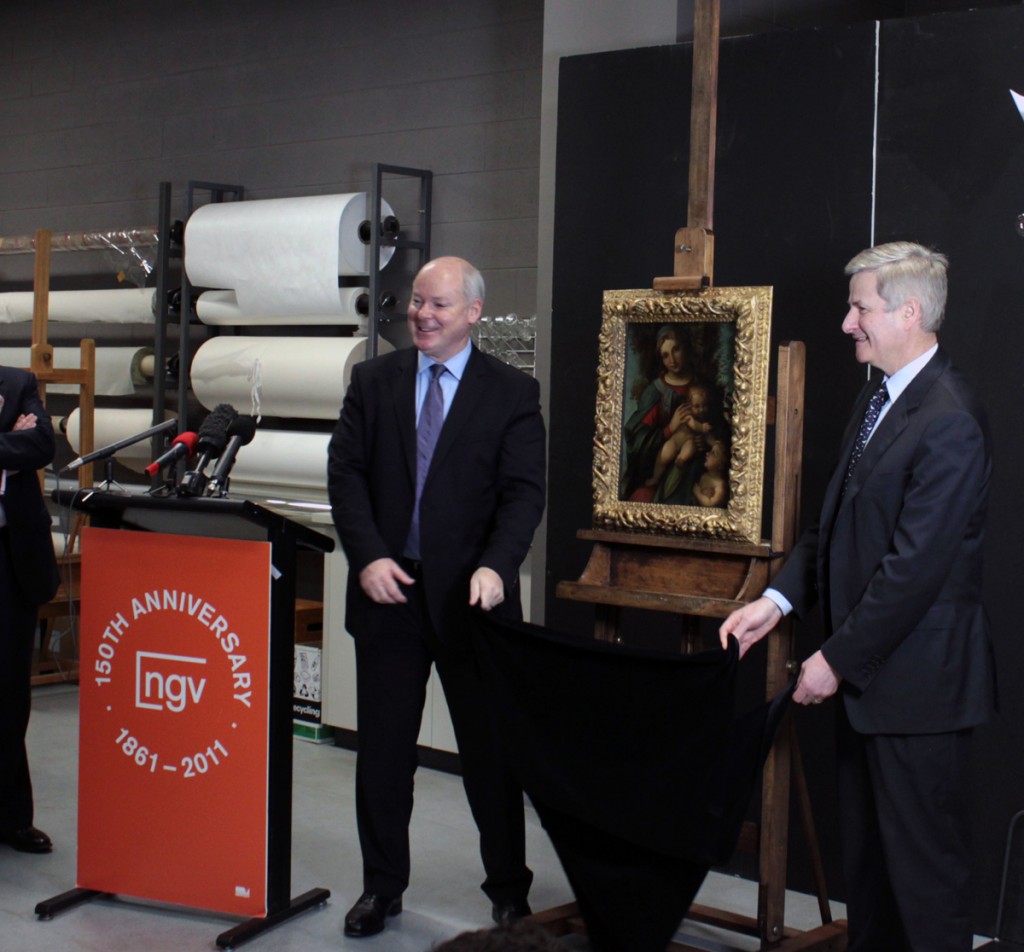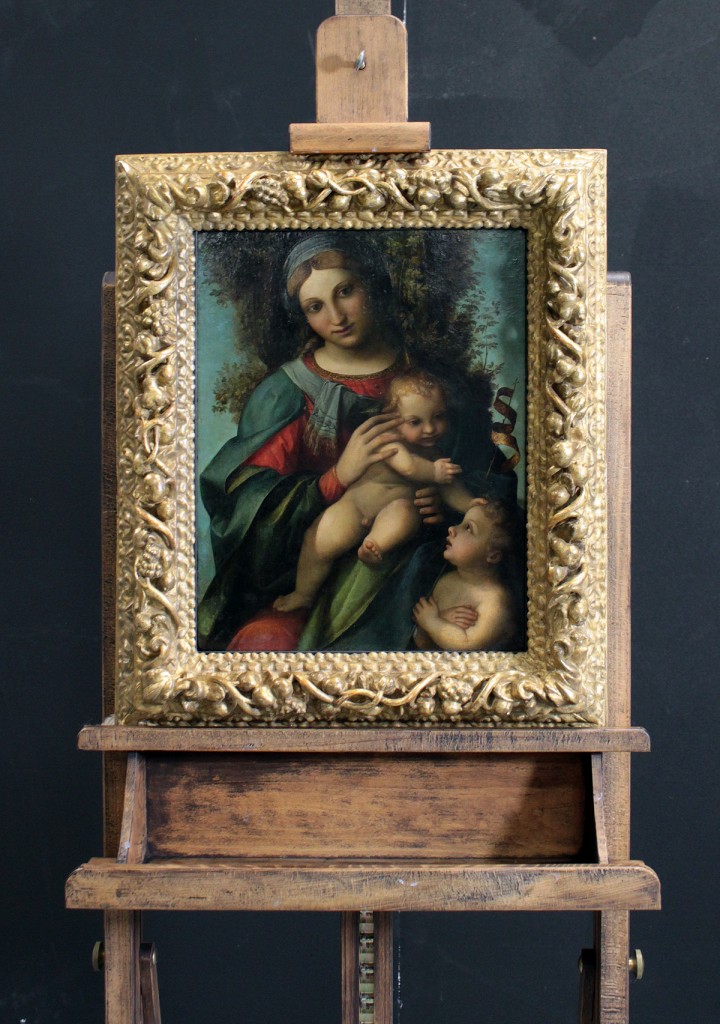
NGV Director Gerard Vaughan and NGV Trustee Andrew Sissons (who donated the funds for the purchase) unveil the NGV's latest purchase. Picture: Katrina Grant.
Opinion: Thoughts on the NGV’s latest acquisition: Correggio’s Madonna and Child with the Infant St John the Baptist by David R. Marshall
The NGV today announced the purchase of a newly discovered painting by Correggio (Antonio Allegri) of the Madonna and Child with the Infant St John the Baptist at Sotheby’s 7 July sale. By chance I was shown this painting in late May when I was looking at something else, and had an interesting discussion about it with the people from Sotheby’s, including their conservator who was doing the conservator’s report. It was not an attention-grabbing picture at first sight (especially as it was a little yellowed by varnish), but gradually the subtleties of Correggio’s hand and imagery began to emerge.
It is an early work, which is always interesting with Correggio because, like Giovanni Bellini, he begins slowly, emerging from the shadow of Mantegna and the school of Leonardo, before becoming truly himself in the later 1510s. Unlike Bellini, but like Michelangelo, his early works show anticipations of what is to come, as if the true Correggio vision was always there and was just awaiting the opportunity to emerge. My experiencing of the painting, as it was picked up from where it was leaning against the wall and put it flat on the table so that we could peer at it properly, was the analogue of this.
Gradually one saw more and more echoes of his later works (if echoes backward in time are possible), and gradually Correggio himself emerged from what was at first sight seemed to be a routine Renaissance Madonna. First it was the hair of the Christ Child, that prematurely receding-at-the-temples hairline with the feathery, golden curls that would become one of the most commented–on features of his work from Vasari onwards, and which would be turned into fine but hard gold threads by Parmigianino, his closest, and most perverse, follower.
Then it was the colour harmony between that particular Correggio red, the pale green of the inside lining of the Madonna’s cloak, and its blue outer surface (then a bit yellowed by the varnish). This prompted a spirited discussion of what was, at the left, the inside of the lining and what was an exterior fold. The conservator, perceiving hard-to-see traces within the paint surface, was convinced that the yellowish fold closest to the sleeve was the lining; I was not so sure, reading this as a colour shift on the exterior of the cloak. It will be interesting to see who was right.
Then there was the way the hill and its vegetation clustered around the head of the Madonna, leaving clear sky at the edges only. This was like the right side of the Virgin and Child with the infant Baptist in Chicago.
Then there was the pose of the Christ child, and I found myself cycling through Correggio’s greatest hits before settling on Leonardo’s Madonna of the Yarn Winder. That turned out to be only half right, but what was clearly Correggio himself was the way the left hand of the Christ Child touched the head of the Baptist, and you realised that here was already that linking movement between three figures running diagonally across the canvas that would characterize his great late altarpieces like the Holy Family with St Jerome (Il Giorno) and the Madonna della Scodella in Parma.
The head of the Baptist then emerged as having a degree of intimately observed naturalism that distinguishes Correggio’s work: Correggio loved children and women. This naturally led to a study of the Madonna’s face, which was disappointingly schematic, the besetting sin of Renaissance Madonnas: a bit of Leonardo in the mouth, a bit abstract in the eyebrows and eyelids. Yet the eyes themselves seemed to be alive. Cruising back over it again and again, the quality and condition began to emerge more and more strongly. Too many paintings don’t quite make it in these departments and this kept looking better and better.

Correggio (Italian 1489-1534), Madonna and Child with Infant John the Baptist, 1514-15, oil on wood panel, 45.0 x 35.5 cm. National Gallery of Victoria, Melbourne. Purchased with funds donated by Andrew Sisson, 2011.
Back in Melbourne, these disinterested responses are given a new edge, on learning that the buyer was the NGV. It fits the pattern of recent NGV purchases: quality and especially condition are very good, but driving it all is the Art History 101 preoccupation I have written about before on MAN. Correggio, as was recognised by the middle of his century, was one of the big four of what we call High Renaissance painting, as exemplified by the later sixteenth-century trope that maintained that the finest painting conceivable would be an Adam and Eve where Adam was drawn by Michelangelo and painted by Titian, and Eve was drawn by Raphael and painted by Correggio. That trope makes Correggio a colourist, or perhaps more accurately a painter whose qualities emerge in the execution rather than the conception. It may therefore be fitting that the NGV’s High Renaissance ‘Raphael’ is actually a Francia (without allowing this analogy to obscure the distinctive originality of Francia’s conception, which is quirkier every time I look at it) and its Correggio is actually a Correggio: a merely Correggiesque picture would not do the trick. Raphael’s reputation was built on his capacity to conceive images embodied in works he hardly touched; but not so Correggio. To have a real Correggio is crucial; and to have succeeded in obtaining a work by this very rare painter is quite an accomplishment.
At the same time, it has to be acknowledged that what got people excited about Correggio, from the sixteenth to the eighteenth centuries (culminating in Mengs’ worshipping of La Notte and Il Giorno in Dresden, leading to his rediscovery of the Camera di San Paolo in Parma) was his mature work. Looking at one of his masterpieces, one is in no doubt as to why he was so highly regarded. Looking at this Madonna, however, one tends to look past it to what is come, as I have been doing. This means that it might not blow away an uninformed audience, or one not attuned to Correggio already, although one should never underestimate the pulling power of a Madonna. Perhaps it is too much to ask for one of these. Some may remember one such when the Martyrdom of Four Saints came to Melbourne in David Jaffé’s Rubens and the Italian Renaissance exhibition in 1992: then no one was is any doubt that one was in the presence of a masterpiece, of such importance that it should probably not have travelled.
So it comes back to the question of whether it is better to have a work that fills a gap in the NGV-as-Janson/Gardner/Hartt’s-history-of-art, or whether it is better to go after works that might have a more immediate presence. This of course brings us to the question of price, since it is question of where to deploy resources (although the singularity of such works is what generates the funds to buy them). It is better to adopt the strategy or buying more, and cheaper paintings, to built a bigger and more comprehensive collection and with an eye to impact? It is an interesting thought experiment to see what you could have got with the same money at the two big London Old Master sales in July. The top price was a large Guardi, at over £20 million. At two metres wide, and of top quality, there could be no complaining about such a purchase on grounds of either art historical importance or public spectacle. Christie’s keynote work was even pricier: a work by Stubbs, likewise big, spectacular, and of top quality. Probably the Stubbs was the riskier buy, since various forces are at work boosting his reputation, and may have succeeded excessively well. But such prices are, of course, through the roof and it is noticeable that both pictures went over estimate, confirming the general trend that the top pictures are going ever higher, while the middle range pictures (those around the £100,000–£500,000 mark) are languishing. The Correggio, at £3,625,250/ $5.2 AUD (including buyer’s premium) was the second most expensive picture in the Sotheby’s sale, if not in the same league as the Guardi and the Stubbs, and made it to the cover of the catalogue. With the Australian dollar being what it is, a lot cheaper than it would have been. But compared to top-end contemporary art, it is a pretty good deal, especially because of Correggio’s historical importance and the rarity of his works. And these are undoubtedly the drivers of the price and the NGV’s interest. What it needs to be weighed against is the ten £360,000 (or five £720,000) paintings that could have been bought with the same money. Aesthetically, I am in two minds about this; but the decisive argument is probably this: good paintings will always be obtainable, but a Correggio probably never will again. So the NGV is to be congratulated on taking the plunge.
© David R. Marshall 2011
N.B. The painting is now on display on level 1 of the NGV International and will remain there for about three months. It will then undergo a conservation treatment including the removal of the old varnish and small losses and damages will be inpainted. It will go on display with the other 16th-century works in the North Mezzanine gallery around the middle of next year. The painting was purchsed for the NGV with funds donated by Gallery Trustee Andrew Sisson.
